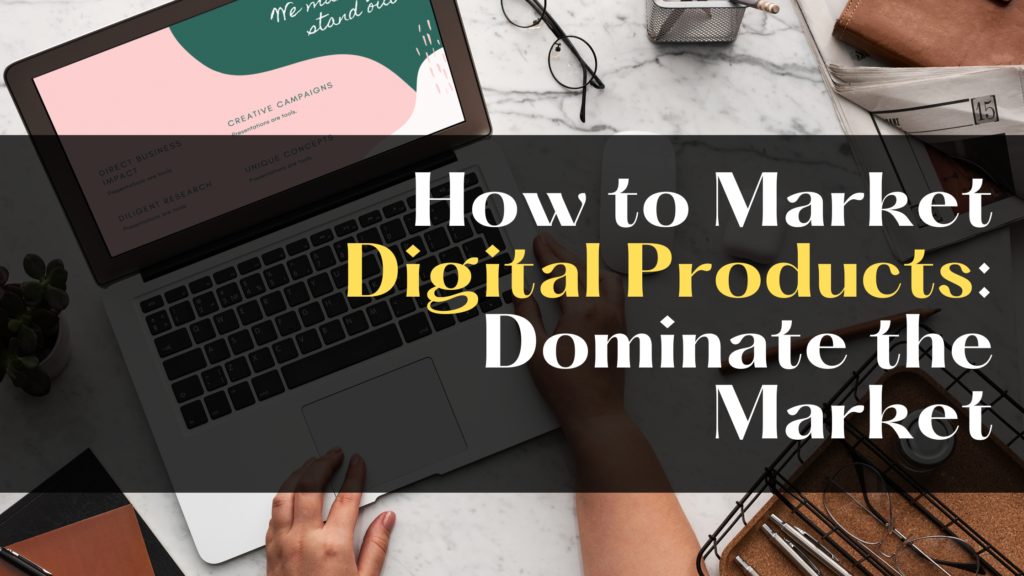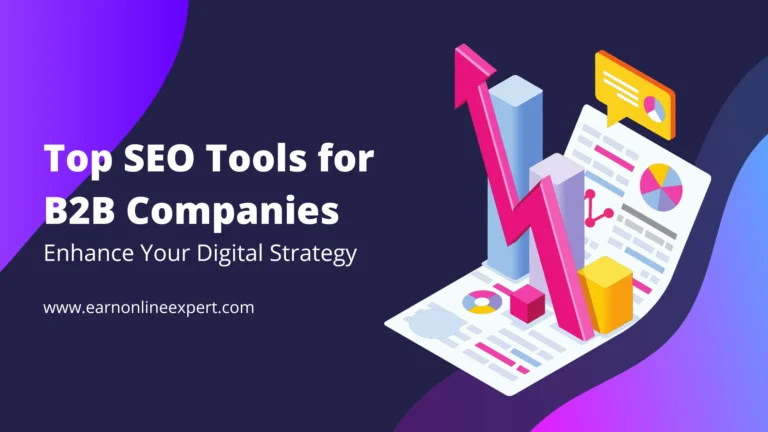
Table of Contents
How to Market Digital Products: A Comprehensive Guide
In this comprehensive guide, we’ll explore the best strategies for how to market digital products effectively, covering everything from understanding your target audience to leveraging social media, building email campaigns, implementing paid advertising, and optimizing your efforts for maximum impact.
Introduction
In today’s digital era, the world of products has undergone a seismic shift. Digital products have emerged as a game-changer, revolutionizing the way businesses operate. From e-books and online courses to software applications and multimedia assets, these intangible offerings have become an integral part of our daily lives.
However, the rise of digital products has also ushered in a unique set of challenges when it comes to marketing. Unlike traditional physical products, digital goods require a different approach to promotion and sales. Businesses need to adapt to the ever-evolving digital landscape and implement effective strategies to reach their target audience and drive conversions.
In this comprehensive guide, we’ll delve into the realm of digital product marketing, exploring tried-and-true tactics and innovative approaches. By understanding the nuances of this domain, you’ll be equipped to craft a robust marketing strategy that resonates with your audience and propels your digital product towards success.
Understanding Your Target Audience
Before embarking on any marketing endeavor, it’s crucial to gain a deep understanding of your target audience. Digital products often cater to specific niches with distinct pain points and preferences. Failure to grasp these nuances can lead to a disconnect between your product and your potential customers, resulting in underwhelming sales and wasted marketing efforts.
To avoid such pitfalls, start by conducting thorough market research. Analyze industry trends, competitor offerings, and consumer behavior to identify your target audience’s needs. Engage with them through surveys, social media interactions, and focus groups to gain valuable insights into their preferences and pain points.
Armed with this knowledge, you can create detailed buyer personas that represent your ideal customers. These personas will serve as the foundation for tailoring your marketing efforts, ensuring that your messaging, channels, and tactics resonate with the right people. By understanding your target audience intimately, you’ll be able to craft a marketing strategy that speaks directly to their desires and addresses their specific challenges.
Developing a Solid Content Marketing Strategy

In the digital realm, content reigns supreme. A robust content marketing strategy is essential for educating, engaging, and nurturing your target audience. By creating valuable and informative content, you can position yourself as an authority in your industry, build trust with potential customers, and drive organic traffic to your digital product.
Leverage various content formats, such as blogs, videos, and webinars, to cater to different learning styles and preferences. Your content should not only educate but also entertain and inspire, fostering a deeper connection with your audience. Consistently publishing high-quality content will establish you as a thought leader and increase the likelihood of conversions.
Furthermore, optimizing your content for search engines (SEO) and user experience is crucial. By incorporating relevant keywords and adhering to SEO best practices, you’ll improve your digital product’s visibility on search engines. Additionally, ensure that your content is easy to consume and navigate, providing a seamless experience for your audience across various devices and platforms.
Leveraging Social Media and Influencer Marketing
In today’s digital landscape, social media has become an indispensable tool for promoting digital products. Establishing a strong presence on relevant social media platforms can amplify your reach and connect you with your target audience. Engage with your followers by sharing valuable content, responding to comments and messages, and fostering a sense of community around your digital product.
Additionally, collaborating with influencers can be a game-changer for your marketing efforts. Identify influential individuals within your niche who have a dedicated following and align with your brand values. By partnering with these influencers, you can tap into their established audience and leverage their credibility to promote your digital product.
Run targeted social media campaigns and promotions to generate buzz and drive conversions. Leverage the power of user-generated content, testimonials, and social proof to build trust and credibility with your audience. Continuously monitor and analyze your social media presence, adjusting your strategies as needed to ensure maximum impact and engagement.
Building an Email Marketing Campaign

Despite the rise of various digital channels, email marketing remains a powerful tool for promoting digital products. Growing your email list through lead magnets and opt-ins is an effective way to nurture potential customers and keep them engaged. Offer valuable resources, such as e-books, checklists, or exclusive content, in exchange for their email addresses.
Once you’ve built a substantial email list, craft engaging and personalized email sequences. Share valuable content, highlight your digital product’s features and benefits, and offer exclusive promotions and discounts. Segment your email list based on subscriber behavior and preferences to deliver targeted and relevant messaging.
Don’t forget to promote your digital products through email newsletters and announcements. Keep your subscribers informed about new releases, updates, and special offers, fostering a sense of excitement and urgency. By consistently providing value and nurturing your email list, you’ll increase brand loyalty and drive conversions for your digital products.
Implementing Effective Paid Advertising Strategies

While organic marketing efforts are essential, paid advertising can accelerate your digital product’s growth and reach a wider audience. Explore various paid advertising platforms, such as Google Ads, social media ads, and industry-specific platforms, to amplify your visibility. Conduct thorough research and analysis to identify the platforms and channels that align with your target audience’s behavior and preferences.
Once you’ve selected your advertising platforms, create targeted ad campaigns based on audience data. Leverage advanced targeting options, such as demographic, geographic, and interest-based targeting, to ensure your ads reach the right people. Continuously monitor and optimize your ad campaigns for better return on investment (ROI), adjusting your targeting, messaging, and budgets as needed.
Remember, paid advertising is an investment, and it’s crucial to approach it strategically. Set clear goals and key performance indicators (KPIs) to measure the success of your campaigns and make data-driven decisions. By effectively leveraging paid advertising, you can amplify your digital product’s visibility and drive qualified traffic to your sales funnels.
Offering Discounts, Bundles, and Upsells
Pricing and packaging strategies play a significant role in the success of digital product marketing. Develop attractive pricing models that align with your target audience’s perceived value and willingness to pay. Offer discounts and bundle deals to incentivize purchases and increase the perceived value of your digital products.
Implement upsell and cross-sell techniques to maximize revenue and provide additional value to your customers. After making an initial purchase, offer complementary products or premium versions of your digital offerings. These tactics not only boost your revenue but also enhance the overall customer experience and foster long-term loyalty.
Additionally, consider offering limited-time promotions and scarcity tactics to create a sense of urgency and drive conversions. Leverage psychological triggers, such as fear of missing out (FOMO) and social proof, to influence purchasing decisions. However, it’s essential to strike a balance and avoid overcrowding your audience with excessive promotions, as this can lead to fatigue and disengagement.
Utilizing Affiliate and Referral Marketing
Affiliate and referral marketing can be powerful drivers of growth for your digital product business. Leverage the power of affiliate marketing by partnering with influencers, bloggers, and other relevant individuals or businesses in your niche. Provide them with marketing materials, resources, and attractive commission structures to incentivize them to promote your digital products.
Implement a referral program to incentivize existing customers to refer friends, family, and colleagues. Offer rewards, such as discounts, free products, or cash incentives, for successful referrals. Not only does this help you acquire new customers, but it also fosters brand loyalty and advocacy among your existing customer base.
Equip your affiliates and referrers with the necessary tools and resources to promote your digital products effectively. Provide them with customizable marketing materials, swipe copy, and tracking links to ensure a seamless and successful promotion process. Regularly communicate with your affiliates and referrers, offering support and sharing tips and best practices to maximize their efforts.
Measuring and Optimizing Your Marketing Efforts
As with any marketing endeavor, it’s crucial to measure and optimize your efforts continuously. Set clear goals and key performance indicators (KPIs) that align with your overall business objectives. This could include metrics such as website traffic, email list growth, conversion rates, and revenue generated.
Leverage analytics tools to track and analyze your marketing metrics in real-time. Identify which strategies and channels are performing well and which ones may need adjustment. Regularly review your data and make data-driven decisions to optimize your marketing efforts for better results.
Continuous improvement and adaptation are key to long-term success in digital product marketing. Stay up-to-date with the latest trends, technologies, and best practices in the industry. Experiment with new strategies and tactics, and be open to pivoting your approach based on the insights gleaned from your data and customer feedback.
Conclusion
Marketing digital products in today’s saturated market requires a strategic and multi-faceted approach. By understanding your target audience, developing a solid content marketing strategy, leveraging social media and influencers, building email campaigns, implementing paid advertising, offering attractive pricing and promotions, utilizing affiliate and referral marketing, and continuously measuring and optimizing your efforts, you’ll be well-equipped to navigate the digital product marketing landscape successfully.
Remember, digital product marketing is an ongoing journey of learning and adaptation. Embrace the challenges, stay agile, and continuously refine your strategies based on data and customer feedback. With perseverance and a commitment to excellence, you’ll be able to craft a compelling marketing strategy that resonates with your audience and propels your digital product towards sustainable growth and success.



